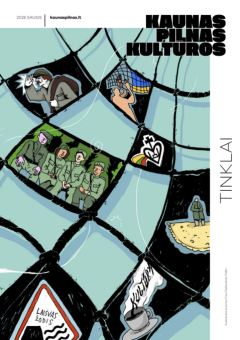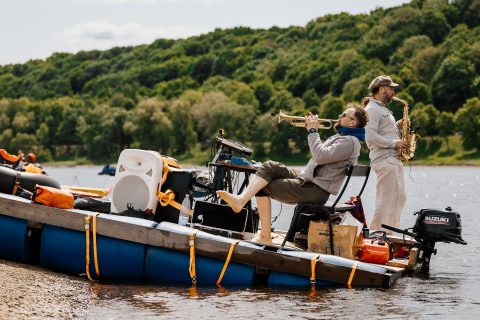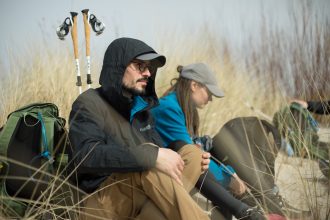The people of Kaunas never had a dilemma as to where to take a first-time guest to the city: it would be hard to say how many tourist routes started on Laisvės avenue and ended with sunsets at the confluence of the Nemunas and the Neris.
Such is the geography of Kaunas – here all the roads lead to the water. Although today the first thing we find here is the company of the Nemunas romantically winding into the distance, our ancestors would see a much livelier scene: hoisted sails (later, steamboat smoke) and the clamor of rivermen in boats, which created the river-like character of our city for hundreds of years.
After several decades of stagnation, it is difficult for the younger generation of residents to imagine Kaunas as a port famous throughout the region, but the elder people still remember how lively the rivers were: crowds of passengers waiting on the banks and the usual leisure time of the residents, looking at the city from the water. Today, as we stand at the confluence, we unfortunately see the ominous construction of the millennium. However, boats again return to the city via the rivers, albeit timidly.
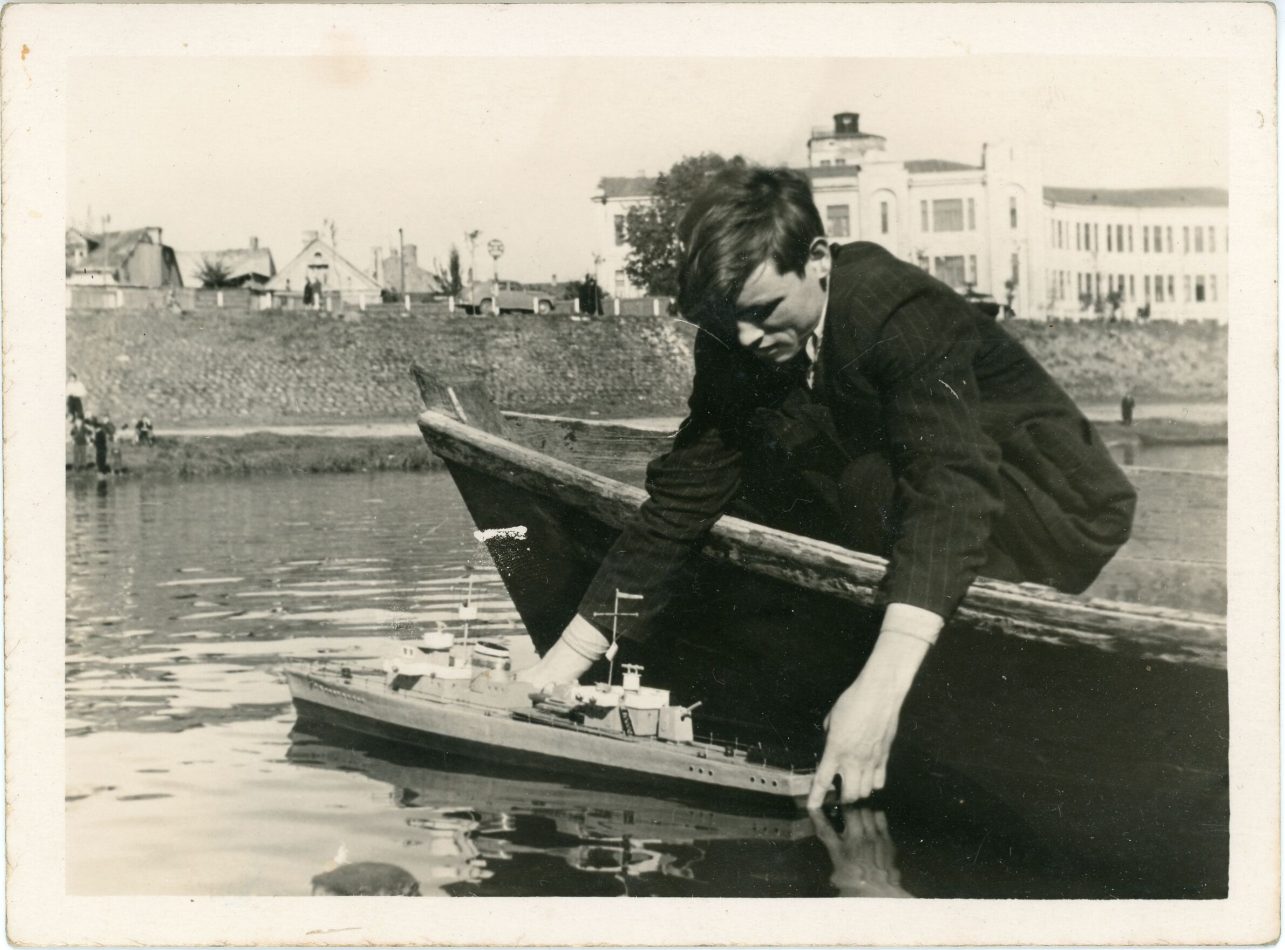
Since the olden days, boats have been moored in the Old Town, near the church of Vytautas the Great. That is where all the riverboats, flatboats, baidaks, and later steamboats were loaded. Passengers were also accepted on boats, determined to reach Karaliaučius, and from there perhaps more distant lands. One could take the Nemunas waterway without having any ambitious goals, to simply travel to the lower reaches of the Nemunas or neighboring towns.
In the 19th century when the ideas of romanticism were trending, rivers and their banks served as an ethnographic research field. Konstantinas Tiškevičius organized the first scientific expedition in 1857. He traveled by boat via the Neris, starting at its headwater and going all the way to its confluence with the Nemunas. The purpose of the trip was to hydrographically, historically, archeologically, and ethnographically explore the Neris and its banks. This was the first such wide-scale attempt to carry out a comprehensive study and describe Lithuanian rivers and their banks. This example was later followed by Zigmantas Gliogeris and Vladislavas Sirokomlė who romantically described the 19th-century life of the Nemunas riverbanks with its traditions, local myths and legends, cultural monuments, etc.
In the same century, the industrial revolution finally reached Lithuania, which was enslaved by the Russian Empire, albeit quite late. Technological progress, which manifested in industry and science, has also spread widely in transport. Fueled by firewood and coal, a steam engine began to be used in boats. Communication has become faster and more convenient. With the modernization of technology, society has also become more modern and more aware of the importance of leisure time. In Kaunas, next to a walk around the city and other pleasures provided by it, people were choosing to spend their free time in or near rivers. The townspeople liked to walk along the banks of the rivers, and in the warm season, the water of the Nemunas and the Neris rivers was perfectly refreshing.
After Lithuania’s statehood was restored, and when Kaunas soon became the temporary capital, an active part of society, primarily the intelligentsia, sought respite in the country. Steamboats were often used to travel to the resorts outside Kaunas or further out. In 1926, after constructing a new passenger pier on the water in the old town of Kaunas, travel conditions improved significantly. The dock had a waiting room, a ticket office, and a small luggage compartment. Kiosks were located nearby to purchase fruit drinks, smokes, snacks, and fish. From it, people traveled to Aukštoji Panemunė, Lampėdžiai, Babtai, Kulautuva, Zapyškis, Kačerginė, Vilkija, Jurbarkas, Smalininkai and the Baltic Sea. There was no shortage of people traveling by water transport, in 1931 only inland waterway transport was used by as many passengers as the current population of Kaunas: about 300 thousand. During the interwar period, the Kaunas passenger pier became an important transportation station and one of the public spaces of the temporary capital. Crowds of people gathered at the passenger pier to see off travelers. Curious people also came to see the “show” of steamboats. Sirens would blare when the boats were departing, and each boat had a different sounding one. The spectacle was created by black smoke that was pouring out of the steamboat chimneys and the splashing water that was created by the moving paddle wheels.
In the era of the temporary capital, the Lithuanian Yacht Club in Kaunas was considered the center of the country’s water sports. Almost all sports of that kind cultivated at that time were concentrated here. The founding meeting of the club took place in 1922. It is interesting that Vainio Aarnio, the first consul of Finland who took office at a similar time, and who had 18 years of experience in the field of water sports, was admitted to the club as a member-sponsor. The club grew rapidly and eventually moved from its modest location near the Aleksotas Bridge to the tip of the Nemunas island: a ferry was also installed from I. Kanto Street.
In 1932, when the club’s tenth anniversary was celebrated, it already had about two hundred members. On that occasion, a large commemoration was organized on Nemunas Island, which was attended by the country’s most important people. A rather exceptional program was presented to those gathered. Lietuvos aidas wrote, “… there was a race of various boats. A plane appeared through the tree-covered peaks of the Aleksotas hills … The nimble plane piloted by Mikėnas, would descent up to several meters above the motorboats and drop a “bomb” on each of them – a bag of flour – which, when falling, gave an impression of a real one.” Although the “bombardment” was not very successful and touched only one boat, there were other losses, “One “bomb” knocked off the peak of one captain’s hat and another exploded and filled the motor with flour… After this, the motorboat was unable to continue the race.” By the way, even during the difficult war years, the club continued its activities. A more modest commemoration of the 20th anniversary was held in 1942, “… during the commemoration, there were swimming competitions and the Venetian Duel, pole walking, rescuing of a drowning person, relay race, boating with obstacles, rescuing overturned kayaks and those who were in them, comical jumps…”
In 1936, the residents of Kaunas and the guests of the city were able to observe an impressive spectacle on Army and Society Day. A huge carnival of ships and boats was organized between Nemunas Island and Vytautas the Great Bridge on May 16. After the employees of various organizations, societies, institutions, and factories marched through the streets of the city, the audience gathered to watch a theatrical show in the water. It was written in the press that five illuminated steamships stopped on the Aleksotas’ side. Rockets were launched from these ships and powerful lighting was organized. Soon, a string of ships and boats, decorated with lights and flags, also appeared on the “water stage”. Several motorboats depicted warships with cannons, there was also a replica Viking ship, as well as racing and sea scout boats and hundreds of other small boats and kayaks. Rockets and other fireworks were fired from many of them. At the end of the event, after the signal was given out by steamboats, the sky was lit with fireworks. 35,000 spectators watched this celebration. By the way, in the same year of 1936, the Lithuanian Yacht Club became an integral part of the Riflemen’s Union.
Professor at Vytautas Magnus University, hydrologist Steponas Kolupaila deserves special mention. The scientist actively travelled the rivers and lakes of Lithuania and invited others to do the same. He joined the scout organization in 1933 and began to popularize water tourism. He organized several trips on the Nemunas, for example in 1934, he organized a week-long kayaking trip from Kaunas to Klaipėda on the occasion of the first Maritime Day in Klaipėda. In the same year, 120 people with 60 kayaks participated in the kayak trip from Alytus to Kaunas organized by Kolupaila. By 1940 he and his companions had organized about 20 such trips, which later spawned at least a few publications dedicated to water tourism as well.
People of Kaunas used the rivers for short trips too. For example, in 1929 in Kaunas and its suburbs, where the traffic was most intense, 40 boat owners had permits to move people around. Of course, in a city that has faced the rivers since time immemorial, many people living next to the riverbanks had their rowboats. They were used for traveling, fishing, and in the spring, to save people from the floods.
Owners or co-owners of steamboats and baidaks lived in the Lithuanian river shipping center. Many of them owned several or even four or five ships that transported passengers and cargo on the Nemunas. Such Lithuanian shipping companies as Lietuvos Baltijos Lloydas and Lietuvos garlaivių bendrovė also had their headquarters here. The first one, if not for the Soviet occupation, would probably have become the main transporter on the inland waterways of Lithuania and would have also significantly raised the bar of water transport. The company actively developed infrastructure both on the riverbanks and in the water. It had 4 steamboats, 7 motorboats, and 21 baidak.
During the second Soviet occupation, river transport centered in Kaunas was strictly controlled by the occupation authority. Private ideas and initiatives were often stifled. Despite this, the people of Kaunas sailed to the resort towns outside the city by steamboats, and later by passenger motorboats, fleeing from post-war worries and the unknown. During the years of occupation, water sports also returned to the slow flow of the Nemunas. 1948 could be considered the beginning of the yacht club’s restoration, when sailing courses were held at the sports club of Kaunas University, with a very modest inventory at first. The first post-war motorboat competition was held in Kaunas only in July 1953.
The high-speed Rocket ship came to Lithuania in 1962. This date marks a new page in the history of river transport. The steamboats that served as the transport on the Nemunas since the mid-19th century were abandoned in 1958, and they were slowly replaced by motorboats and Rockets. A total of 5 Rockets operated in the Soviet Lithuania. Four ships served passengers on the routes: Kaunas–Nida, Kaunas–Klaipėda with intermediate stops in smaller towns. One operated in the Kaunas lagoon. High-speed boats that appeared at the beginning of the navigation season reminded many of the upcoming summer vacations and were often called white swans by the general public. The city’s winter port was moved from Nemunas Island to Vilijampolė in the 70s, and in 1980, the passenger pier was raised at the old town quay next to the port, which had been the main stopping place for ships for centuries.
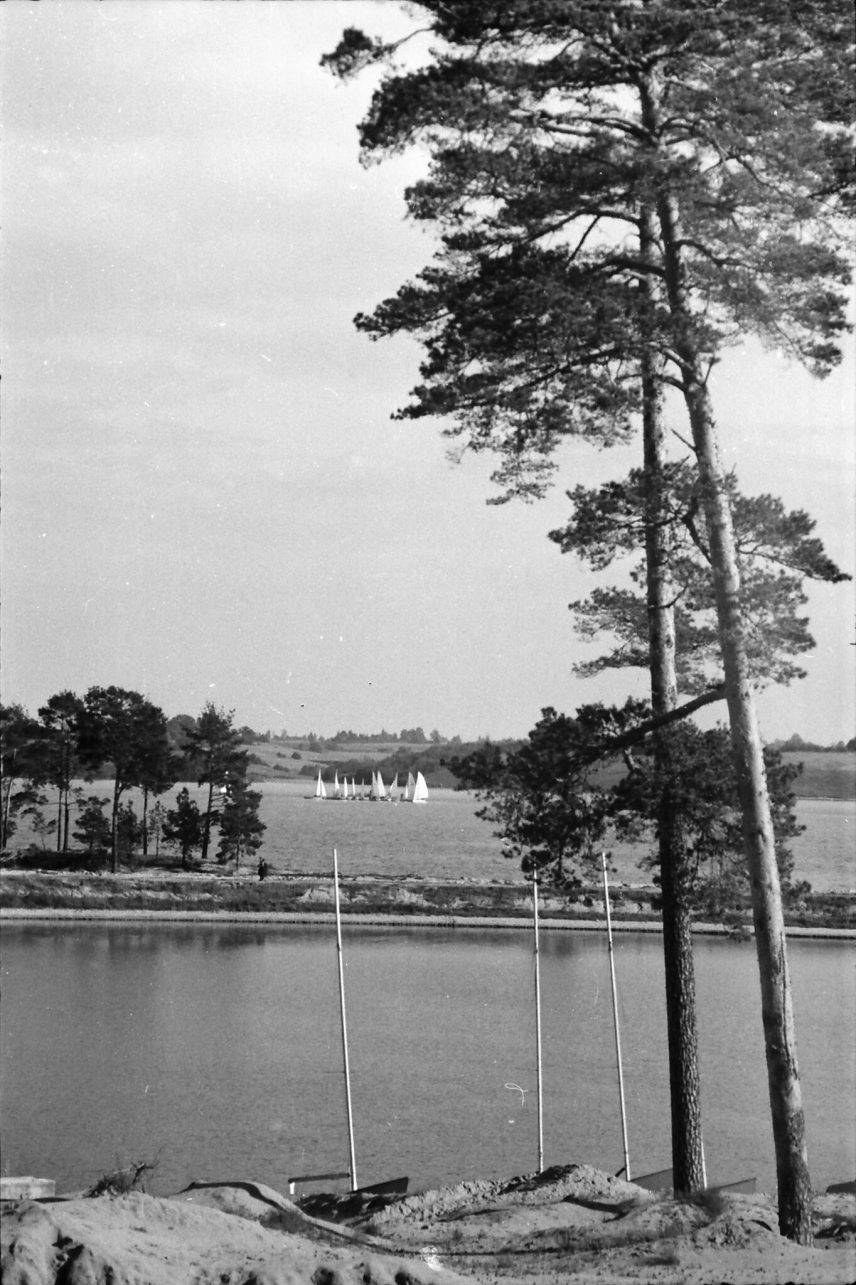
At the turn of the 50s and 60s, after the Kaunas lagoon was dammed, another body of water appeared, where the city’s sailing and swimming enthusiasts soon began to gather. At the start of the lagoon, many uncoordinated processes took place at its shores, although later those bad practices were stopped, and the shores of the reservoir were developed taking into account the recreation needs of the townspeople. The new lagoon also became a haven for motorboats and the city’s yacht club was also moved here. A building was erected for its needs in 1976. The shores of the lagoon became a popular place for boat trips and high-speed boats like Zaria and Raketa would transport people to newly organized allotment gardens and the Open-Air Museum of Lithuania. The so-called Neptune festivals – the small equivalent of the Klaipėda Sea Festival – were also held next to Kaunas Lagoon (but not only).
As with many things, river transport was affected by the transition to a market economy, with shipping not seeing the best of times at the turn of the century. However, for example, in 1994 statistics say that 595 motorboats and almost one and a half thousand rowing boats were registered in Kaunas city and the district. In 1999 at the first Kaunas city festival, perhaps the most popular highlight was the parade of illuminated boats Down the River (by the way, it took place up the river); the Neptune festival was revived in the same year and was held on the Nemunas island. Although almost all the Rockets left Kaunas in the early 21st century, in 2002 during the navigation season, 2 private vessels and 8 vessels belonging to the Directorate of Inland Waterways navigated the Nemunas and the lagoon. Only after almost twenty years, in 2020, the last remaining Rocket on the Nemunas started going to Nida again.
Water sports have not disappeared from the Nemunas and Kaunas Lagoon. In 2011 a new kayak slalom track was opened near the railway bridge. Until then Kaunas residents had to hold competitions in the Vokė, which is located next to Vilnius. Although passenger shipping in the Nemunas has been slowly recovering in the last decade, and citizens’ interest in riverside activities is growing, the faster revival of river culture is hindered not only by the economic factor but also by broken traditions, the forgotten past of the port city, which is being gradually opened up by initiatives operating in Kaunas. One such initiative is the virtual model of the historical port city of Kaunas created by the cultural river research platform TẽKA, available at www.upynes.lt.
